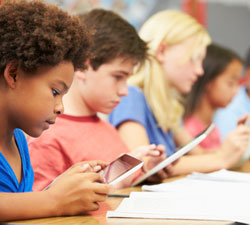Go Off Book: Creative Teaching Alternatives

Each child is unique. Sure, we all know this to be true, yet we routinely try to force all students to learn in the same orthodox ways. As a parent, sometimes you have to think outside the traditional education box to boost your child’s interest and learning potential. To engage your children, you must find new and creative resources to foster their development. Activities like games, “real life” exercises, and collaborative teaching can be great additions to any parent’s toolbox, and can help you steer your young learners down the right path in their academic endeavors. Here are some tools and approaches that offer creative learning outside of the conventional confines of the textbook:
Play Games
Educational gaming, a form of active, participatory learning, encourages problem solving, procedural thinking, and collaboration in students of all ages, notes the Horizon Report. More sophisticated games, like multiple player games, can promote community and teamwork. For grade school children, learning-centered games have shown substantial progress in increasing children’s interest in school subjects, while honing their coordination and reasoning skills. Some companies, like iWin, offer quality online games that can focus a child’s attention on vocabulary, puzzle solving, and matching activities, which promote memory and association capacities. Games can provide your child with an entertaining and engaging activity and in turn may provide you with the opportunity to put your feet up for a few minutes.
Simulate Real World Scenarios
Simulations help students connect to the world around them, notes the Center for Teaching and Learning at University of North Carolina. They offer the learner specific parameters and choices within those parameters. For younger kids, a parent can simulate a grocery store experience where multiple items are priced and available for purchase, but the “shopper” only has an allotted amount to spend. The child must then choose wisely and not go over budget.
For more advanced students, you can incorporate the objective of selecting items that represent the food groups. Such an activity reinforces mathematical skills, challenges children to make their own decisions, and also mirrors a practical life experience. If you’re lucky, it might even encourage your child to think twice while at the supermarket with you, and not to pull every colorful product in the aisle into your cart.
Use Peer-to-Peer Teaching
Peer-to-peer teaching also capitalizes on the concept of active learning. The premise is simple: teach one lesson to one child, then have that child teach it to another. In general, youths view their peers as credible informants and find it easier to identify with other children than with adults, notes a report from Oxford University. The act of learning from peers engages children with each other, while the act of teaching a concept to peers solidifies the knowledge in the the minds of both the student-teachers and the student-learners.
Peer-to-peer teaching often occurs naturally with siblings, following the concept that kids tend to mimic behaviors that they see. But organizing this phenomenon with specific learning material can focus comprehension on specific educational outcomes, rather than encourage the younger tyke to imitate the older child’s messy bedroom habits.
If your child is not responding well to ordinary learning activities, he or she may just need an alternative approach. Break free of the box. Go off book. With tools like games, scenarios, and peer interaction, your child can see that learning is not only important, but is also fun.




